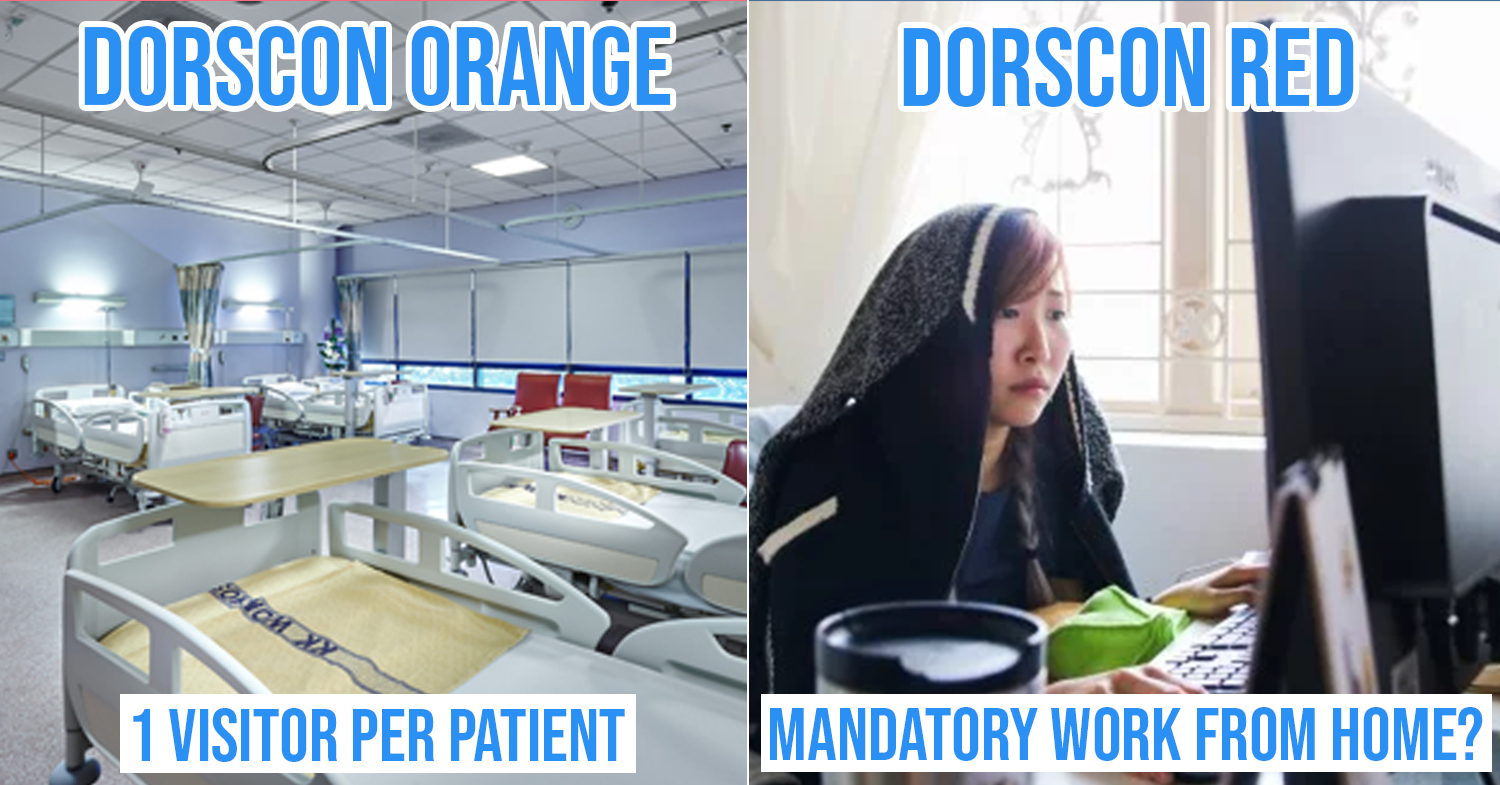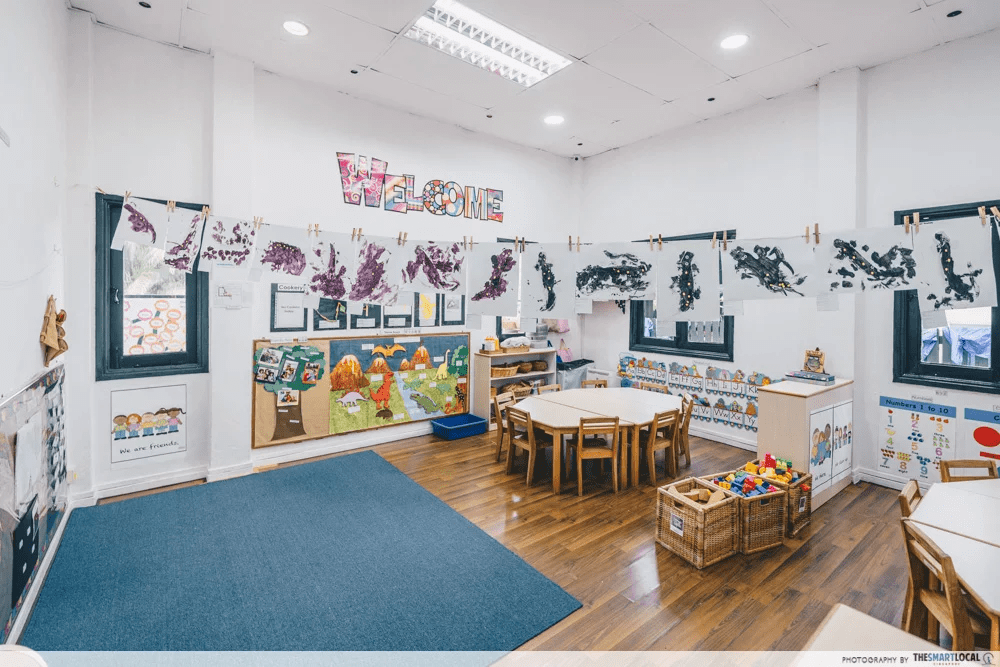COVID-19 DORSCON Orange and Red guide
 Image credit: KKH, Tetra Park
Image credit: KKH, Tetra Park
With the raising of the COVID-19 DORSCON alert from Yellow to Orange in recent days, plenty of us have freaked out, both internally and externally, leading to a zombie apocalypse-style supermarket wipe-out.
Overly dramatic? Maybe, but it’s important for us to keep our wits about us as well. Here are some grounding facts you need to take note of now that we’ve hit DORSCON Orange, as well as what you’ll need to prepare for in the unfortunate event that we hit Red.
For the latest DORSCON level and reliable updates, refer to the MOH website.
What is DORSON anyway?
An acronym at the tip of everyone’s tongues these days, DORSCON stands for Disease Outbreak Response System Condition and is a risk assessment framework used to speed up our response to a public health threat.
 Image credit: Ministry of Health
Image credit: Ministry of Health
Arranged much like difficulty levels in a game, alert Green represents a mild situation like MERS in 2015. Cases in Yellow to Orange are more severe and include instances like H1N1 and SARS respectively. Red is a worst case scenario and something we’ve yet to face as a country – and we hope we never have to.
On top of the number of people infected, DORSCON also takes into account a bunch of factors including the disease situation overseas, how transmittable the virus is, and the impact it might have on the community in Singapore.
– DORSCON Red –
In a worst case scenario where Singapore hits DORSCON Red, you’ll probably be holing yourself up in your home, living off your pantry stash and avoiding the outside world.
DORSCON Red alert would mean that the coronavirus is spreading widely from person to person within Singapore, and there will likely be a significant number of deaths. Thanks to the swift response of the government, we’ve never had to face a DORSCON Red alert, but if it does happen, here are some of the things that might want to prepare for, according to the MOH Pandemic Readiness and Response Plan (2014):
Do note that these possible scenarios are based on pure speculation of what might happen in the event we do enter the Red zone.
1. Closure of schools
While the Minister of Education Ong Ye Kung has announced in mid-Feburary this year that there are no plans to shut down schools, it is still a probable scenario if the disease somehow escalates into a full blown Red alert pandemic, according to the MOH response plan.
School closure might sound dire, but if it makes anyone feel any better, we’ve been through this before once during SARS and came out fine. Education will continue and students can expect to continue lessons on e-learning or online lectures.
2. Mandatory work from home orders

Image credit: TheSmartLocal
As it is, offices are already viewed as chambers that will increase the likelihood of you getting infected thanks to the sheer number of people gathered in a space and sharing the same facilities.
In Red alert, work-from-home arrangements might become mandatory, especially if the disease is found to be highly transmissible and severe. Work may even halt in more severe cases for certain industries that could cause mandated no-paid leave for workers.
3. Cancellation of mass events
A step up from being just a friendly reminder, events might be forced to cancel. Imagine highly anticipated happenings such as F1 or the countdown being pulled off the calendar – that’s gotta be a real downer, but at least we won’t be rubbing shoulders with asymptomatic virus carriers.
– DORSCON Orange –
A DORSCON Orange alert indicates that the COVID-19 is “severe”, easily transmittable, but not widespread. We’ve seen waves of memes, fake news and Singaporeans being kiasu with the announcement of DORSCON Orange, but here are some of the key procedures that have been announced by Ministry of Health (MOH):
1. Postponement or cancellation of national school games, learning journeys and camps
Bad news for students out there: expect the fun extracurricular activities like inter-school competitions, CCAs camps and learning journeys to come to a complete standstill until 22nd March 2020 at least – which is the end of the term break – to combat the spread of the virus.

Image credit: Tetra Park
School definitely won’t be cancelled, at least not while we are on Orange alert – but there will be plenty of changes to minimise large gatherings, so students won’t be congregated sitting ducks should one kid be infected.
Specific measures include assemblies being held in the classrooms, staggered recesses and CCAs being held in smaller groups, which worried parents might be glad to hear.
For JC grads, A-level results can now also be collected online, which circumstance aside, might be what a number of students are rejoicing over as they won’t have to face judgement and curious questions from peers.
2. Temperature checks twice daily at workplaces
This might’ve already been implemented in your workplace, and if it hasn’t, it very well should be! Temperatures should be taken twice daily at workspaces, according to MOH, to make sure no one’s a walking disease spreader – coronavirus or not, during this period.
Working while sick could have once been a sign that you’re a hard worker, but if you’re burning up at an oral temperature higher than 37.8 deg C, it is now a sign to go home asap.

Image credit: @mychurchfotocaptures
Fever in itself is not really a cause for you to check yourself into the NCID, where coronavirus patients are being quarantined. But if it’s accompanied with symptoms like dry cough and shortness of breath, make sure to seek medical attention immediately.
3. Temperature screening and tighter visitor limits at public hospitals
Hospitals are perhaps the last place you’d want to walk in to now. But life goes on and if you have a family member who’s warded in a public hospital and are intending to pay them a visit, you might be glad to know that there are extra screening measures in place.
This includes the collection of travel declarations and mandatory temperature screenings, with unwell visitors being turned away.

For patients in the ward, only 1 or 2 visitors – instead of the usual 4 – are allowed at any time during visiting hours. So make sure the entire fam does not head down at once, lest you all be stuck at the lobby, waiting for your turn to visit. The same goes for patients visiting a centre or clinic within the hospital – only one accompanying person is allowed per patient.
For suspected or confirmed coronavirus cases, there are strictly no visitors allowed to contain the spread of the virus.
4. Office workers might be asked to work from home

With the recent dramatic affair of the Marina Bay Financial Centre’s DBS office evacuating 300 staff after an employee tested positive for COVID-19, we all the more need to be ultra cautious at the workplace.
Many business owners have already enforced work from home schemes and if your workplace has yet to do so, there’s a high chance it’s bound to happen soon.
P.S. For procrastinators who’ve trouble working from home, check out our list of productivity hacks to keep your KPI rolling strong.
5. Limited preschools visits and social/ eldercare services

For working parents, the show must go on. Preschools remain in operation for now with ramped up safety measures in place such as visitor limitations to protect the young ones. Only workers necessary to keep the school running – like contractors – will be allowed in. After temperature screenings, of course. Parents won’t be able to enter the premises either, but you can still continue to pick up and drop off their children at the preschool.
The elderly aren’t left on the ledge either as similar visitation limits will also be placed on elderly care centres – a well-fenced layer of protection, considering that they are more vulnerable to the disease.
6. Advisory to cancel or defer events
Checking your emails is important – but more so now than before with the advisory for organisers to cancel or postpone non-essential large-scale events. If you’ve booked tickets to a concert or event recently, make sure to double check if there are any changes to the plan.
For organisers proceeding with their events, necessary precautions like temperature screenings at the entrance, rejection of unwell attendants and collection of travel declaration are recommended.
7. Advisory to minimise contact with other people

A harmless business meeting was responsible for the spread of at least 4 COVID-19 cases at the Grand Hyatt Hotel earlier this year, and that’s certainly scary enough to put us all off physical contact, no matter how professional we want to appear.
Replace the classic handshake with a friendly smile while meeting clients for now. The hygiene concern probably runs 2 ways given the situation in Singapore, and the other party will probably also be glad to for the workaround.
Other changes to take note of:
Restricted travel entry from China
For those who’ve been living under a rock, since 1st Feb 2020, Singapore has banned the entry of non-citizens who have travelled to China in the last 14 days.

Air travel between Singapore and China will be a lot tougher than usual, many airlines such as Singapore Airlines have limited their flight schedule between the 2 countries.
LOA implemented to Singaporeans who are returning from China
As an extra layer of precaution, those who have been to China within the last 14 days will need to take a Leave of Absence (LOA) from their jobs.
Those under LOA need to:
- Stay home and monitor your health; and see a doctor promptly if sick
- Minimise visitors and keep a record of people you come into contact with
- Minimise your time in public places and contact with people
So no, you can’t go out for that hangout sesh with your friends if you’re under LOA.
Fun fact: Employers will also receive $100 a day for each Singaporean, PR or work pass holder serving the LOA.
COVID-19 DORSCON in Singapore
Speculations aside, we’ve got high hopes for our country to effectively fight and eradicate the disease just as we did previous pandemics like SARS and H1N1.
We’re actually relatively well in tackling the spread of the COVID-19 virus. So while we take extra precautions in our daily life, it’s also very important to remember that eventually we’ll recover from this, just like we did SARS and many other diseases before that.
Check out our other COVID-19 related articles below:
- Where to get masks, hand sanitisers and thermometers in SG
- Easy tips to avoid the Coronavirus
- Popular food places in SG now with zero wait time
- Inspiring coronavirus hero stories in SG
- Coronavirus memes in SG




